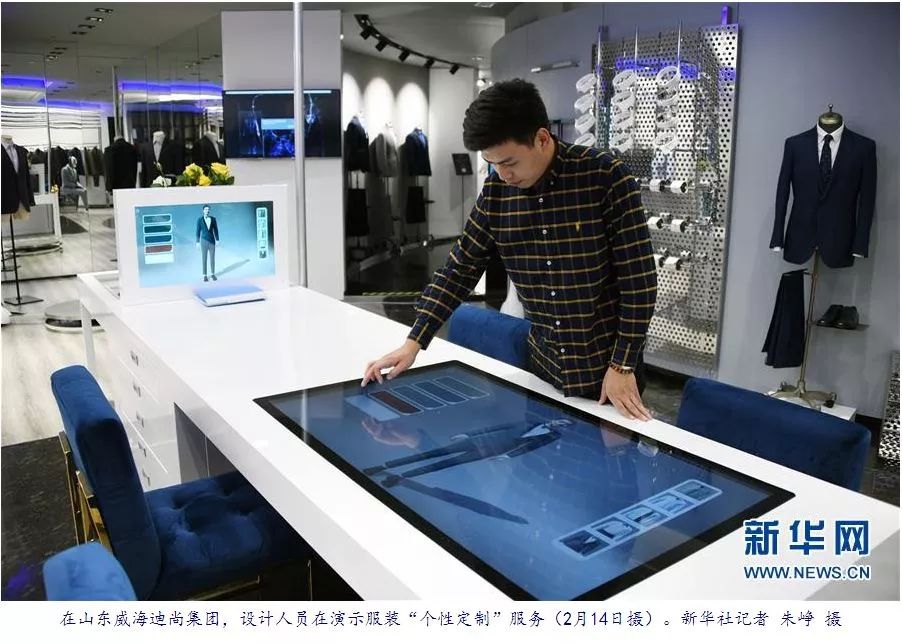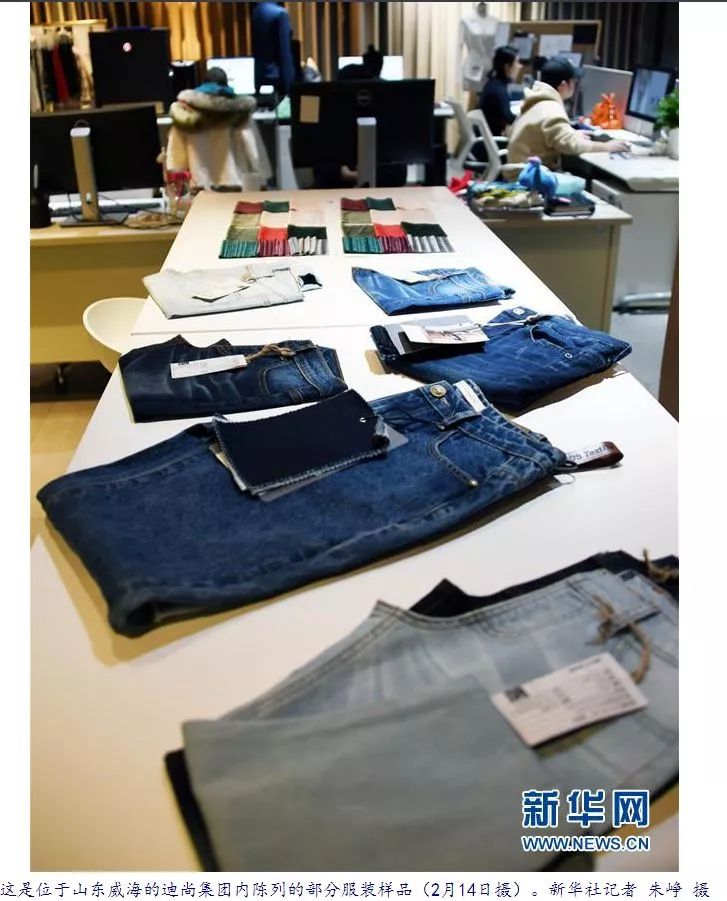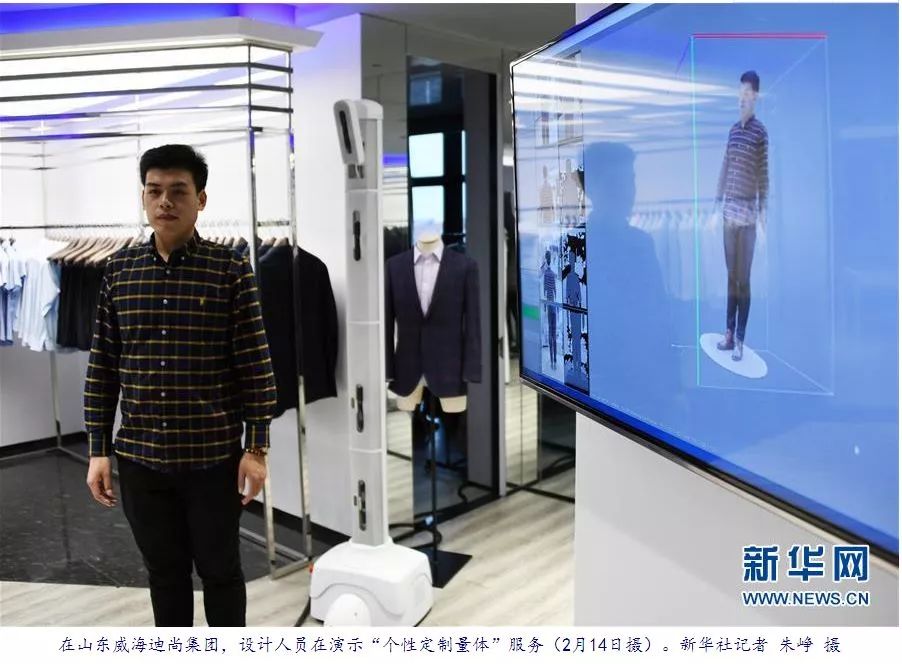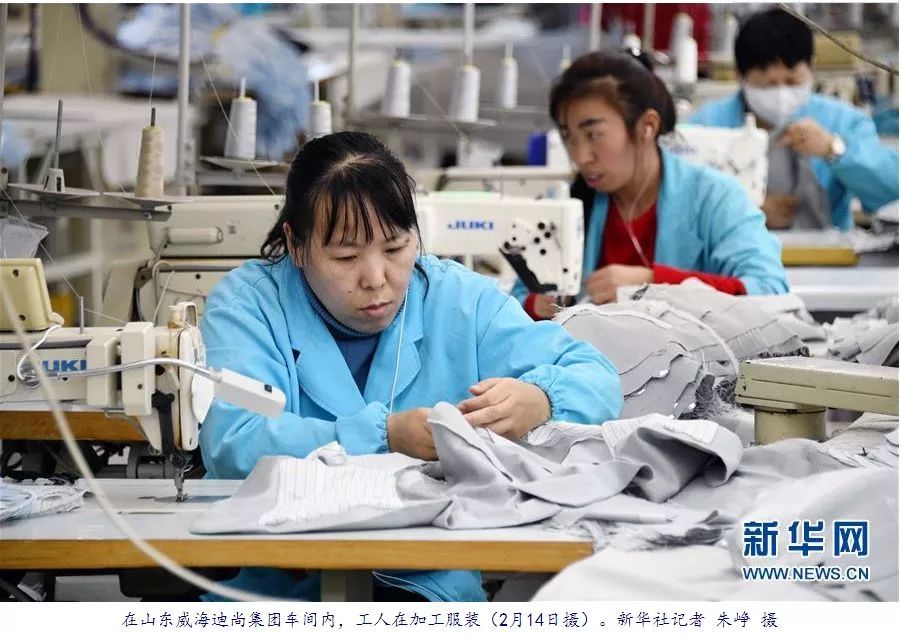Cn-down > Domestic news > News content
2019-06-15 来源:新华社 浏览量:3184
Sitting in the office of Weihai Dishan Building, Yu Xiao, a female designer, is concentrating on operating a computer, modeling clothes scanned by a "black box" in 3D. She is about to complete the digital prototyping and then present them to foreign customers thousands of miles away through the network.
Traveling through Harold Square in Manhattan, New York, Zhu Lihua often recognizes that clothes on the way out are designed and manufactured by Deschamps Group. As the chairman of the company, he has long been accustomed to this --- in the nearby famous Messi Department Store, more than 20 internationally renowned clothing brands are supplied by Dizanne.
Dichan was born in 1993. From a small garment foreign trade enterprise, it has completed the leap from sample processing to independent R&D design, digital design and manufacture, and the export of its own brand. It has become a well-known "server" of the whole supply chain in the international garment industry.
From "earning sweat money" to "tailoring clothes" for the whole world, Deschamps Group has come all the way to add footnotes for the transformation of new and old kinetic energy of traditional industries and the high-quality development of China's economy.

The "invisible champion" of the whole supply chain: Every year, hundreds of millions of "Deschamps" make their way to the world
Just after the end of the Chinese Spring Festival holiday, Russian businesswoman Svetlana Naumova took a nearly 10-hour flight to the Weihai headquarters of the Dishang Group. Over the past four years of working with Deschamps, her order to Deschamps has risen from $1 million in 2014 to about $12 million in 2018.
Naumova runs a down jacket brand. After investigating more than 10 international apparel suppliers, she finally decided to "love" Dizanne. She said: "Deschamps is rich in fabric resources, professional designers, high production efficiency, is the world's clothing supply chain service brand."
For foreign customers like Naumova, Deschamps Group receives thousands of batches every year - international apparel companies take the initiative to discuss cooperation on their doorsteps, which was something that Deschamps dared not imagine 20 years ago.

In the early 1990s, various kinds of garment enterprises sprang up rapidly. Deschamps started with a desk and chairs and started clothing trade.
"At that time, orders were transferred to several international operators, and what they did and how they were done were the ones who has the final say, and the connections and buttons were sent by customers." Zhu Lihua said that without the right to speak, he was often depressed, deducted and even defaulted by the middlemen, which was the pain of the clothing foreign trade enterprises including Didsan at that time.
With the outbreak of the Asian financial crisis, China's foreign trade orders have decreased dramatically, the growth rate of garment exports has declined, and a large number of garment OEMs with extensive management have collapsed, even foreign-funded enterprises have appeared "runaway". The pain made Duchamp determined to get rid of intermediaries and open up independent trade channels.
"Because of the existence of foreign middlemen, we did not even have the opportunity to meet downstream customers." Zhang Ying, deputy general manager of Deschamps Group, has gone through this difficult period and has eaten many times "closed door".
Faced with the international apparel brand enterprises, the Duchamps have made great efforts: to investigate the product positioning of customers in the stores, to find the company's address by all means, to visit repeatedly with ready-made clothes, not to get a second-hand order is also OK... Zhang Ying's most difficult customer is an enterprise in Nagoya, Japan. Since 2001, the team has been visiting for four years before getting the first order.

After ten years of sharpening the sword, Deschamps finally broke through the "middle obstruction" of foreign trade and set up trading companies in the United States, Britain, Germany, Italy, Japan and South Korea, forming a direct channel covering the major countries of Europe, America and Asia to connect with downstream customers.
In order to change the predicament of purely earning contract fees, Deschamps began to expand the whole garment supply chain service: build a garment fabric database covering 300,000 electronic files of more than 3,000 domestic and foreign suppliers of fabric accessories; set up more than 100 designer studios, design companies and research and development centers at home and abroad.
From working as an agent to looking for an agent, Deschamps is constantly changing the scene in the industrial chain. More than 50 professional garment factories, more than 800 supporting cooperative enterprises and satellite factories support the rapid response of Deschamps to trends and orders. At present, di Shang has laid down production bases in many countries along the "one belt and one road" along Burma, Kampuchea, Bangladesh and so on.
"Today, we provide production and service for nearly 500 internationally renowned clothing brands. Nine of Japan's top 10 apparel companies cooperate with Deschamps; in Europe and the United States, Deschamps also ranks first in market share..." Zhang Shizhe, Deputy General Manager of Dishan Group, introduced.
Reporters see that the production of Dichan not only Zara, GAP and other relatively popular clothing, but also high-end brand products such as Jania, Armani, Masmara.
In 2018, Deschamps produced more than 100 million brands of clothing worldwide, and its main business income reached 12.3 billion yuan.

Converging Global Brain: Integrating World Clothing into "Chinese Design"
When half a cup of water is poured onto a jacket, the water droplets roll off and there is no water stain on the surface of the jacket - a waterproof and wind-proof fabric specially developed by Deschamps for rainy countries in Europe, which is very popular in the market.
Independent R&D and design is the key to achieve the transformation from big to strong.
After China's accession to the WTO, the competition in garment processing industry has intensified. How to improve market share, increase added value and transform customer trust into customer dependence has become a necessary question for Zhu Lihua. And he focused on the core competitiveness of the garment industry - design.

At that time, our garment enterprises talked about independent design in front of foreign large-brand enterprises and designers, which could be said to be a kind of class trick. Zhang Shizhe said: "Whether it is talent accumulation or fashion awareness, we all have gaps."
The capacity of the barrel was determined by the short board, and the team of Deschamps breathed a sigh for the design of the barrel. Lagging behind the fashion front, they follow customers to the target market, while learning design, while striving for orders; lack of talent, Zhu Lihua hired designers to Europe at a high price to promote young domestic designers.
Our forefathers have a wide margin. In 2008, with the outbreak of the global financial crisis, China's apparel exports fell sharply, but Deschamps went up against the market, and even boldly went overseas to hire designers, buy Apparel Design companies, and directly absorb the world's cutting-edge design resources.
In recent years, Deschamps has set up the Deschamps European Garment Research and Development Center in the UK, set up branches and workstations in Ireland, Spain, Germany, Belgium and other six countries, and recruited thousands of people in Europe to collect information and keep abreast of the latest trends in the global fashion front.

From making suggestions to participating in design, to designing a style, a series and a category independently, Deschamps'design is gradually integrated into international brands. It has become the norm to design and develop with large-scale customers.
"At present, the trend of division of labor in the apparel industry is that well-known international enterprises hand over R&D and design to suppliers. The other side often only gives us fashion trends, fabrics selection, design refinement, production processes are completed by us. Sun Shiguang, Assistant General Manager of Deschamps, said.
Today, almost all of the products produced by the Deschamps Group contain independent design elements; every month, Deschamps can launch 10,000 new fashion designs. In the field of high-end garment processing, Deschamps has formed a deep-rooted influence through independent design. Zhu Lihua said, "We used to look for customers all over the world, but now we prefer customers."
Dalian Dishang Huasheng Fashion Co., Ltd., which is owned by Dishang, is a Japanese company with continuous losses. After being acquired by Dizanne, its self-designed mid-end products can produce profits equal to the high-end products designed by customers, and become manufacturers of international famous brands such as Armani, Masmara and so on.
With the transformation from "Made in China" to "Created in China", self-owned brand building has become the latest direction of the transformation and development of Deschamps. Through overseas acquisitions, Deschamps Group has five apparel companies and 10 independent design brands in the United States, including Brandon Thomas and Chery Elegance Fashion.

Developing Intelligence Industry: Let China be the "tailor-made" of the world
An innovative way to strengthen China's economy; an innovative clothing to activate an enterprise.
"Let scientific and technological innovation play an important role in implementing innovation-driven development strategy and accelerating the transformation of new and old momentum." In Zhu Lihua's blueprint, the combination of new technologies such as big data, intelligent manufacturing, Internet of Things and garment manufacturing has become a magic weapon for mining new "gold mines".
Thick accumulation and thin hair. Reporters in the Dichan Fabric Center see that more than 3000 domestic and foreign suppliers of fabric accessories product information "gather a database" - each material's texture, yarn density, delivery cycle, price and other latest graphic and textual information, forming the source data stream of fabric accessories.

"In the past, we often took customers to Jiangsu and Zhejiang to see the fabrics. Now we can provide the materials to customers online, which is more efficient and faster." Zhang Xiaoteng, supply chain manager of Deschamps, said.
The huge data support enables Deschamps to quickly predict ready-to-wear prices and quickly form digital designs.
Every day, 50 to 100 products in Deschamps complete 3D rendering, and the upper body effect of the product can be visually displayed on the computer. Yu Xiao told reporters that in the past, manual plate-making, sample clothing production, delivery, feedback, modification, re-delivery, plate-setting and other procedures, the fastest time is also a month. Using 3D stereo prototyping, the running errands become data, which can be fixed in a week.
From fabric selection, clothing design to final garment production, Deschamps has entered the door of digital design and manufacturing. New production methods and application scenarios are also beginning to land in Deschamps, which promotes the further development of Deschamps towards high quality.
Four cameras around the human body, one minute can complete the height, shoulder width, waist circumference, leg length and other data acquisition, within a week can produce suitable fashion clothing for customers - this is the latest personalized customization business launched by Deschamps.
"Fabrics, details, buttons can be chosen independently, basically there will be no"collision shirt". Marshal Liu, head of the men's clothing measurement center of Dishan Personality Customization Center, said that there are more than 1000 kinds of optional fabrics in the database for men's shirts alone, which can form hundreds of millions of combinations with different choices such as neckline, cuffs and buttons.

The steady and long-term development of large economies requires the creation of an endless surge of vitality, and enterprises need to constantly break through themselves and find new breakthroughs.
In Deshang, a more ambitious blueprint has been drawn, and 10 key platforms such as Deshang Fabric Center and National Double Creation Demonstration Base have been launched. Depending on the ability of resource integration to develop the platform economy will become a new development focus of Deschamps.
Zhang Xiaoteng introduced that Deschamps plans to launch online trading functions. Among them, the basic development of fabric trading platform will make the existing data resources become a new source of profit after opening up to the society.
"Only sunset enterprises, no sunset industry." Cao Jiachang, president of China Textile Import and Export Chamber of Commerce, said that continuously promoting industrial upgrading is the hope of the industry.
Deeply ploughing the garment market, Zhu Lihua's dream is to promote the transformation of new and old momentum in China's garment industry. "I hope that in the future, when it comes to fashion, people will think of China first," he said.
(Source of this article: Xinhua. com, the copyright belongs to the original author, reprinted please indicate!)
 热门排行
中国三大羽绒生产基地之—广东吴川
全球最奢侈羽绒服排行
一件羽绒服需要多少只鸭子的羽绒?
飞丝是什么?能代替羽绒?别被骗了,三种方法让你告别假羽绒服!
2017羽绒原料价格一路上涨,究竟为何?
你的羽绒服为什么钻绒?涨知识了
羽绒被的价格一般是多少 通过成本看羽绒被价格
中国羽绒服四大品牌调查:到底谁才是最强王者?
羽绒金网:羽毛、羽绒、毛绒计价
《羽绒羽毛》、《羽绒羽毛检验方法》新版标准发布,2017年7月1日实施
热门排行
中国三大羽绒生产基地之—广东吴川
全球最奢侈羽绒服排行
一件羽绒服需要多少只鸭子的羽绒?
飞丝是什么?能代替羽绒?别被骗了,三种方法让你告别假羽绒服!
2017羽绒原料价格一路上涨,究竟为何?
你的羽绒服为什么钻绒?涨知识了
羽绒被的价格一般是多少 通过成本看羽绒被价格
中国羽绒服四大品牌调查:到底谁才是最强王者?
羽绒金网:羽毛、羽绒、毛绒计价
《羽绒羽毛》、《羽绒羽毛检验方法》新版标准发布,2017年7月1日实施
 推荐阅读
“吴川力量”助中国羽绒接轨世界
中国三大羽绒生产基地之—广东吴川
中羽协第二期新国标培训班 在“羽绒之乡”广东吴川成功举办
羽绒之乡:贵港桥圩镇将打造旅游休闲特色小镇
广西贵港桥圩镇:打造中国羽绒休闲旅游特色小镇
羽绒金网:羽毛、羽绒、毛绒计价
羽绒别急着收 中央气象台发布寒潮蓝色预警 部分地区降温超12℃
上海消保委检测 千元鹅绒被用鸭毛绒填充
冻哭丨降温10℃!鸡年首个寒潮预警来袭,你准备好了吗?
传统羽绒产业如何实现转型升级?四川玉泉镇产业集群发展
推荐阅读
“吴川力量”助中国羽绒接轨世界
中国三大羽绒生产基地之—广东吴川
中羽协第二期新国标培训班 在“羽绒之乡”广东吴川成功举办
羽绒之乡:贵港桥圩镇将打造旅游休闲特色小镇
广西贵港桥圩镇:打造中国羽绒休闲旅游特色小镇
羽绒金网:羽毛、羽绒、毛绒计价
羽绒别急着收 中央气象台发布寒潮蓝色预警 部分地区降温超12℃
上海消保委检测 千元鹅绒被用鸭毛绒填充
冻哭丨降温10℃!鸡年首个寒潮预警来袭,你准备好了吗?
传统羽绒产业如何实现转型升级?四川玉泉镇产业集群发展